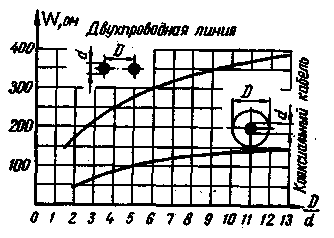
|
|
ENCYCLOPEDIA OF RADIO ELECTRONICS AND ELECTRICAL ENGINEERING Coordination of the antenna with the feeder. Encyclopedia of radio electronics and electrical engineering
Encyclopedia of radio electronics and electrical engineering / HF antennas This question interests many radio amateurs. It occurs, for example, when it is necessary to connect a symmetrical two-wire 300-ohm feed line to the antenna instead of a 75-ohm coaxial cable or, conversely, when replacing a 300-ohm open line with a 75-ohm coaxial one. The feeder can not always be directly connected to the antenna, bypassing the matching device. The issue of performing a compensated transition (or matching device) from the antenna system to the feeder line is one of the main ones in the design of antennas. It is mainly aimed at reducing losses in the feeder by providing a regime in it close to that of a traveling wave. The main feeder line is usually the longest. Therefore, it is desirable to coordinate it with the load as best as possible. Why is there a need for matching devices and what conditions must be met in the manufacture of complex antennas with several pairs of feed points? In a feeder with a given wave impedance, not every load creates a mode close to that of a traveling wave. Conversely, in order to obtain optimal matching of a given load with a feeder, a feeder of a certain wave impedance is required. It would seem that, using the graph in Fig. 1, for many cases of practically encountered loads, it is possible to select a feeder of the required wave resistance and provide an acceptable IBC in it. However, this overlooks the input (output) resistance of the equipment (TV, receiver, transmitter) to which the feeder is connected by its second end. With regard to this resistance, the requirement to ensure coordination with the transmission line is also fully preserved. As a rule, they try to get the value of the input (output) resistance of the equipment close to the value of the wave resistance of serial cables. This circumstance makes it necessary to take special measures to match the antenna with the feeder, the wave impedance of which is selected in relation to the input (output) impedance of the radio.
In the power supply system of complex antennas with several pairs of feed points, additional difficulties arise due to the fact that on the wires of each antenna-element included in the array, it is necessary to ensure the equality of currents in phase and amplitude. The latter is achieved thanks to distribution feeders, which are connected in parallel to the Main, for example, as shown in Fig. 2, a and 2, b. The distribution feeders themselves are already directly loaded onto the antennas. It should be noted that the electrical lengths and wave impedances of distribution feeders included symmetrically in the power circuit must be respectively equal.
Parallel connection of distributive feeders results in a decrease in resistances and it becomes necessary to restore them. The more antenna elements, the more distribution feeders and the more noticeable the decrease in resistance. Nutrition according to the scheme of fig. 2, compares favorably with the previous two, since at connection points 1-1 of the main feeder, the value of the input resistance is restored, which is available at the input of each individual distribution feeder. Indeed, distribution feeders 2, 3, 4 and 5 are connected in pairs in parallel, and the pairs themselves at points 1-1 are connected to the main feeder in series. In this case, the voltage phases supplied to points 1-1 are shifted relative to each other by 180°. For the correct phasing of the antennas, this phase shift must be artificially taken into account by reversing the polarity at the feed points of the antennas 2, 3 with respect to the antennas 4, 5. One of the ways to solve the matching issues is to use line segments with wave impedance wsp.feed as distribution feeders. greater than the characteristic impedance of the main feeder wmain feed. For example, in the diagram of Fig. 2, it is convenient to apply lines with wdistribution feed\u300d XNUMX Ohm at wmain feed= 75 Ohm since, being connected in parallel, these lines will provide the same value of KBV in the main supply feeder, which takes place in each of the distribution feeders. To maintain a similar regime (Fig. 2,b), it is necessary that the line segments 0-3, 0-4, 0'-2 and 0'-5 have wdistribution feed\u300d 0 ohms, and the segments from points 0 and 150 'to the main feeder - respectively XNUMX ohms at wmain feed=75 Ohm. Both in the first and in the second cases, it is necessary to select the antenna elements in such a way that their input impedance in the operating frequency range provides an acceptable KBV in distribution feeders. For matching, resistance transformers are also used, in particular, line segments connected in series. The places of their inclusion in the power circuits are shown in fig. 2 bold lines. Author: Candidate of Technical Sciences K.P. Kharchenko; Publication: cxem.net
Machine for thinning flowers in gardens
02.05.2024 Advanced Infrared Microscope
02.05.2024 Air trap for insects
01.05.2024
▪ Smartphone case with airbags
▪ Telephony site section. Article selection ▪ Article Guilty Without Guilt. Popular expression ▪ article How Emperor Nero averted the troubles foreshadowed by the comet? Detailed answer ▪ Mulberry article. Legends, cultivation, methods of application ▪ article Dimmable LED night light. Encyclopedia of radio electronics and electrical engineering ▪ article Crystals of metallic copper. Chemical experience
Home page | Library | Articles | Website map | Site Reviews www.diagram.com.ua |






 Arabic
Arabic Bengali
Bengali Chinese
Chinese English
English French
French German
German Hebrew
Hebrew Hindi
Hindi Italian
Italian Japanese
Japanese Korean
Korean Malay
Malay Polish
Polish Portuguese
Portuguese Spanish
Spanish Turkish
Turkish Ukrainian
Ukrainian Vietnamese
Vietnamese


 Leave your comment on this article:
Leave your comment on this article: